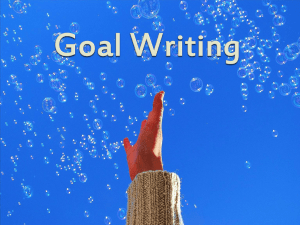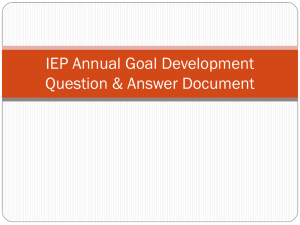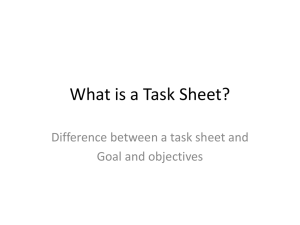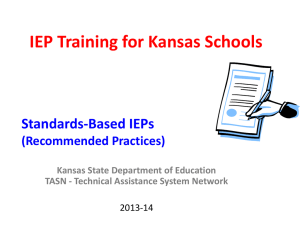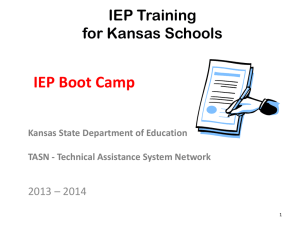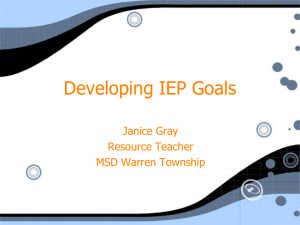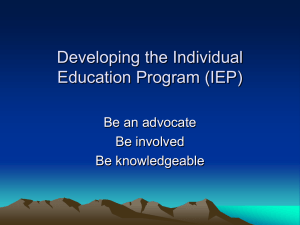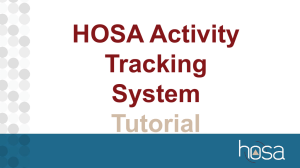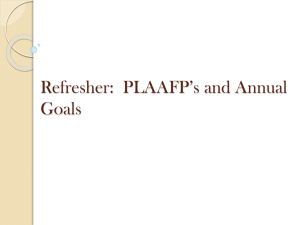TEKS BASED IEPS PLAAFPS and GOALS & OBJECTIVES
advertisement
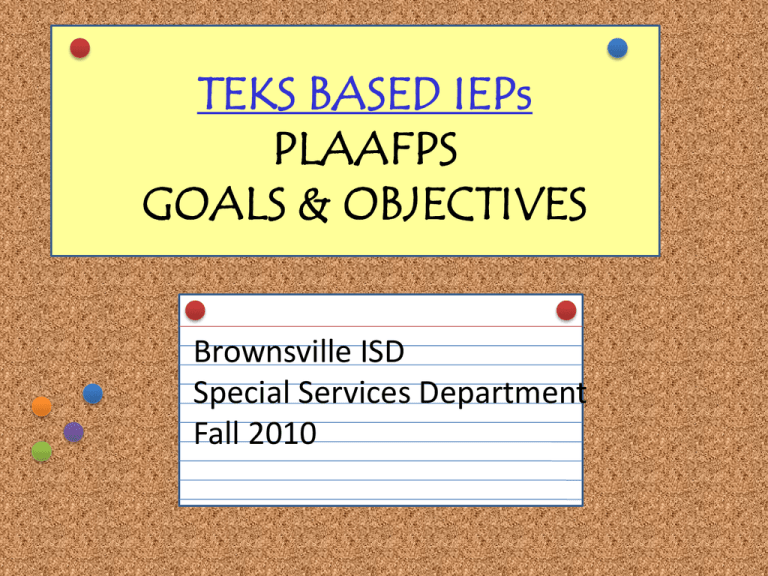
TEKS BASED IEPs PLAAFPS GOALS & OBJECTIVES Brownsville ISD bbRE Special Services Department Fall 2010 Training Outcomes TEKS-Based IEPs’ Decision Making Process Analyze assessment information to determine student strengths, needs and interests. [TAKS-A, TAKS-M, TAKS-ALT, benchmark tests, student work, etc.] Incorporate parent concerns and considerations for current and future conditions. Using assessment information and the Texas Essential Knowledge and Skills, identify areas of need. Collaboration between general and special education teachers is a critical component. Determine the present level of performance for each priority area in specific and measurable terms. Develop measurable goals that allow the student to be involved in and progress in the general curriculum; deconstruction of the TEKS/SEs and Scope and Sequence of the curriculum Definition of PLAAFPs Cornerstone of the IEP Describes child’s strengths in relation to state standards (TEKS) Source that drives the other IEP components Statement that links all IEP components Contain current, relevant information Provides the basis for: IEP goals/objectives Measuring progress The • Identify needs of the student so that all service providers know the PLAAFPs level at which the student is SHOULD……… functioning and so the team can set appropriate, meaningful annual goals for the student. Prioritize and identify needs that will be written as GOALS Provide a baseline data for each need. PLAAFP These sections include: Student’s Strengths, Interests, and Preferences Parent Concerns regarding their child’s education Special Considerations * Behavior * Communication * Limited English Proficiency * Health * Braille * Assistive Technology Transition Assessments Other essential information Effect of the disability Post-secondary Expectations for living, Learning and Working Course of Study The Three Elements of PLAAFPs 1. A narrative 2. A statement of 3. A description of summary of the how the disability area(s) of baseline data. What impacts the educational need. are the sources of student’s What are the information upon involvement/progre resulting priority which the statement ss in the general educational needs is based including the education to be addressed in strengths and what curriculum. the ANNUAL the student is GOALS? currently able to do? Sample PLAAFP READING Baseline Data Impact Need According to results from XYZ test of reading fluency, John is able to read 27 words per minute with 2-3 errors. (A typical 4th grader is expected to read 50 words per minute with zero errors. ) This impacts his ability to complete grade-level reading assignments in a timely fashion. This impacts his ability to be successful in grade-level reading activities. John will need accommodations (extended time, chunking, 14 font min, etc. ) and specialized instruction to complete grade-level reading assignments and tests. ©2006. Division of Curriculum and Instruction, Region One Education Service Center 8 Sample PLAAFP Math Baseline Data Impact Need His math teacher observed that Johnny struggles to process mathematical information in a sequential way, which is critical to the linear nature of algebra. Johnny can complete singlevariable equations with fractions with like denominators. Overall, because of his disability in math reasoning, Johnny is not achieving in the general curriculum on a level equivalent to his grade peers in the area of math. Johnny will need specific algebraic models/ examples and be expected to complete additional practice problems over time. He requires additional specialized instruction, with material presented in an alternate format to aid comprehension and application ©2006. Division of Curriculum and Instruction, Region One Education Service Center 9 What are annual goals? Annual goals are statements that describe what a child with a disability can reasonably be expected to accomplish within a twelve month period in the child’s special education program. These goals are skills and/or knowledge that will be mastered, not an activity. ©2006. Division of Curriculum and Instruction, Region One Education Service Center 10 What is a measurable annual goal? Measurable goals are defined as statements that contain four critical components: timeframe, conditions, behavior and criterion. A measurable goal includes the behavior or skill that can be measured at periodic intervals against a criterion of success. What are the four critical components of a measurable goal? • A. Timeframe identifies the amount of time in the goal period and is usually specified in the number of weeks or a certain date for completion. • B. Conditions specify the manner in which progress toward the goal occurs. Conditions describe the specific resources that must be present for a child to reach the goal. The condition of the goal should relate to the behavior being measured. For example, a goal relating to reading comprehension may require the use of a graphic organizer. The graphic organizer is the condition. • C. Behavior clearly identifies the performance that is being monitored. It represents an action that can be directly observed and measured. • D. Criterion identifies how much, how often, or to what standard the behavior must occur in order to demonstrate that the goal has been achieved. The goal criterion specifies the amount of growth that is expected. 12 What is the Timeframe ? In 8 weeks, given a bag full of folded newspapers and a neighborhood street, be able to throw a paper onto the roof of each house. ©2006. Division of Curriculum and Instruction, Region One Education Service Center 13 What is the condition ? In 8 weeks, given a bag full of folded newspapers and a neighborhood street, be able to throw a paper onto the roof of each house. ©2006. Division of Curriculum and Instruction, Region One Education Service Center 14 What is the behavior? In 8 weeks, given a bag full of folded newspapers and a neighborhood street, be able to throw a paper onto the roof of each house. ©2006. Division of Curriculum and Instruction, Region One Education Service Center 15 What is the criterion? • In 8 weeks, given a bag full of folded newspapers and a neighborhood street, be able to throw a paper onto the roof of each house. ©2006. Division of Curriculum and Instruction, Region One Education Service Center 16 Examples Goal Timeframe Condition Behavior Within 36 instructional weeks using decoding skills Joseph, a 3rd grade and oral practice student, will read within a 3rd grade passage Criteria 70 words per minute with fewer than 10 errors Objective Timeframe Condition Behavior Criteria By the end of the first six weeks using decodable texts Joseph, a 3rd grade student, will read and pronounce 50 frequently used words with 10 or fewer errors Sample Goal & Objective Goal Behavior Timeframe Condition By June 2, 2011 given a 4th grade story prompt and 30 minutes to write Linda, a 4th grade student, will write Criteria a three paragraph essay using transition words in sentences and between paragraphs with 5 or less errors. Objective Timeframe Condition Behavior Criteria In three instructional weeks with guided practice Linda, a 4th grade student, will correctly use transition words to connect simple and compound sentences with 75% accuracy Sample Goal & Objective Goal Timeframe Condition Behavior By the end of the 2010-2011 school year given mixed fraction Jose, a 6th grade problems using all student, will solve operations Criteria 85% of all assigned problems correctly. Objective Timeframe Condition Behavior Criteria By October 1 using prompts that decrease the assistance provided (most-to-least prompting) and through repetitive practice Jose, a 6th grade with 100% accuracy. student, will identify 20 fractions that represent more than a whole number on a worksheet in three minutes or less PLAAFP/SBIEP TEACHER TOOL Developed by Special Services to aid teachers in writing appropriate PLAAFPs and SBIEPs TEACHER TOOL w/SAMPLE TEACHER TOOL (BLANK) They are available on our webpage. QUESTIONS? PLAAFPS
